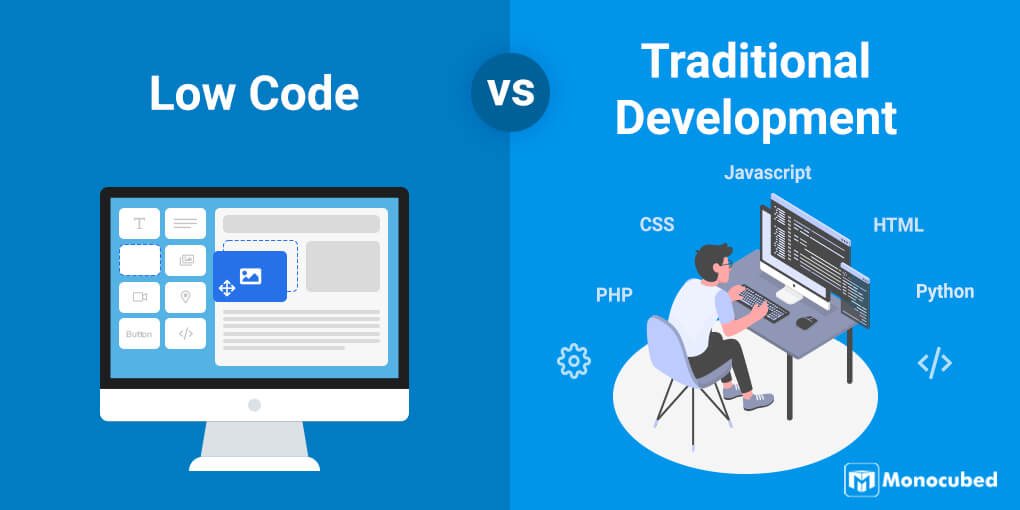Free Info To Selecting application development with Low-code platforms
Free Info To Selecting application development with Low-code platforms
Blog Article
The Benefits Of Low-Code Development For Non-Developers With Regard To Accessibility
App development that is low-code improves accessibility for non-developers (often called "citizen-developers") due to a few key factors.
Drag-and-Drop Builders. Low-code platforms have drag-and-drop interfaces. This allows non-developers the possibility of building applications visually, without writing code. The development process is now more accessible to those who have no technical background.
WYSIWYG editor: The "What you see is what you will get" editors let users design interfaces, workflows and other features in a manner that closely mimics the final result. They are easy to learn and make use of.
Simplified Workflow and Logic Design
Visual Workflow Modeling - Users are able to design business procedures and logic for applications using visual flowcharts and models. This is a lot more efficient than traditional programming techniques.
Pre-built Logical Components: Many low-code platforms have built-in components for logic (e.g. conditions, loops) and can be easily set up. This eliminates the need to code complex programs.
Reusable components and templates:
Template libraries that are pre-built: Many low code platforms provide libraries of the most commonly used kinds of software, giving non-developers to have a foundation that they can build upon and modify.
Reusable Widgets and Modules Users can make use of reused widgets. This makes it easier to create and reduces the need of in-depth understanding.
Tutorials for Guided Development and Guided Development:
Step-by-step guide: Platforms offer tutorials, tips on screen, and guided development paths to assist non-developers in creating applications.
Interactive Tutorials Interactive tutorials that are hands-on and interactive help users learn by doing, enhancing their understanding and confidence in making use of the platform.
Integration with existing tools
seamless integration: Low-code platform are designed to seamlessly integrate with existing systems, tools, and software (e.g. ERP or CRM). This allows non-programmers with no prior experience in programming to design applications that can work seamlessly with their current workflows.
APIs Connectors: APIs integrate into apps to facilitate integration. This allows non-programmers, who don't have programming abilities, to connect to external services.
Collaboration Features:
Team Collaboration: Features like real-time collaborative workspaces, as well as shared workspaces make it possible for non-developers to collaborate effectively with business analysts, developers and other key stakeholders.
Role-Based Access Control: Those who are not developers can be assigned specific roles with appropriate access levels, ensuring they are able to contribute to the development process without compromising security and functionality.
Automated Testing and Debugging
Low-code platforms are often equipped with debugging and testing software that can automatize these procedures. This makes it simpler for non-developers to ensure that their applications function correctly.
Error Highlighting: Whenever issues arise the platform highlights any the errors and suggests solutions and guides non-developers through troubleshooting techniques.
The ability of low-code applications to make development accessible for those who are not developers is its main benefit. Through providing clear, intuitive tools as well as guided experiences low-code platforms allow business users to be actively involved in the creation and maintaining applications, which bridges the gap between business needs and technical implementation. Follow the best Low-code Platform for application development advice for blog info including app dev platform, developing mobile apps, rad development, sso azure, push notifications android, low code platforms, jdbc server, app platforms, rapid action development, rapid action development and more.
Benefits Of Low-Code Application Development In Terms Of Scalability And Flexibility
Low-code software has many advantages when it comes to scaleability. They are flexible and able to be modified to meet new demands. Three benefits are listed below.
Cloud-based deployment: Many low-code platforms use cloud technology, enabling applications to scale seamlessly with the underlying cloud infrastructure. This allows companies to handle increasing loads without worrying over the management of servers.
Auto-Scaling Features - Built-in automatic scaling capabilities automatically alter resources according to the demand. This ensures continuous performance, even during peak times, without the need for manual intervention.
Flexible Architecture:
Modular Design: Low-code systems promote modular application design, which means that components can be created independently as well as tested and scaled. Modularity increases flexibility, and it's simpler to upgrade specific components of an app without having to change the entire system.
Microservices Integrate: Microservices allow applications to grow and become adaptable by allowing them to be constructed as a group of loosely connected services.
Solutions that can be customized:
Extensibility Low-code platforms typically permit custom programming and scripting. This allows developers to expand the functionality of applications beyond what is available out of the box. This allows for unique business needs to be met with no restrictions.
Third-Party Integrations: The ability to integrate with third-party services and APIs permits companies to add additional functions and services as needed, enhancing the application's capabilities.
Agile Development and deployment:
Continuous Delivery and Deployment Low-code Platforms facilitate agile methods by enabling continuous Integration and Continuous Delivery (CI/CD). This allows for the rapid release of updates and new features, ensuring that applications can evolve quickly as a result of user feedback and market changes.
Iterative development low-code development is an iterative process meaning that applications can be adapted and developed in a gradual manner. This decreases the risk of large-scale changes while allowing an controlled growth.
Resource Optimization
Effective Resource management: Low-code platform tools help optimize resource use by monitoring and managing performance of software. They ensure that resources are used efficiently, and can be can be scaled up or down according to the actual needs.
Load Balancing: The integrated load balancing function distributes workloads evenly among servers. This increases the application's capacity to handle the demands of high traffic and also ensures the same performance.
Global Reach
Multi-Region Availability: Lowcode platforms allow the deployment of applications across different regions. Companies can provide users with low-latency worldwide access. This is important, especially for applications with global users.
Localization Support The built-in support for language localization lets applications easily be adapted to different local languages and requirements, enhancing their flexibility in diverse markets.
Maintenance and updates
Low-code applications are visually and are modularly built, which simplifies maintenance. Updates or bug fixes can be completed quickly and without lengthy downtime.
Version Control: Integrated version control systems help manage changes and rollbacks making sure that updates can be deployed without risk and that previous versions can be restored if necessary.
Cost Efficiency:
Low-code platforms can cut development costs because they eliminate the requirement for extensive coding. They allow developers to expand applications without significant expenditure or effort.
Pay-As-You-Go Models - A lot of low-code platforms offer flexible pricing models such as pay-as-you go that is based on the actual usage, growth, and financial flexibility.
The ability to scale low-code applications lets businesses develop strong, adaptable, scalable, and robust applications. These platforms allow for rapid adjustments to meet changing requirements and efficient use of resources and constant improvement, which ensures that the application can grow and evolve in line with business needs. See the most popular Legacy application modernization with Low-code for site tips including lowcode no code, cloud software applications, application modernisation, low code development platforms, rapid action development, azure sql, rapid applications, driver jdbc, application modernization, cross platform mobile app development and more.
Advantages Of Developing Applications Using Low-Code In Terms Of Limitations And The Possibility Of Customizing
Low-code applications are an equilibrative, flexible method that takes into account issues and permits customisation. These are the key advantages: Managing Limitations
The Challenge of Overcoming Complexity
Low-code platforms simplify development by providing templates that are pre-built and components. This allows faster deployment and the development of more complex applications.
Many platforms have guided workflows, which help developers navigate through complicated procedures. They reduce the chance of error and maintain consistency.
Scalability Solutions
Scalability built-in: Low-code platforms usually come with features that allow for scalable architecture. This lets applications take on more load without massive re-development.
Performance Monitoring Performance Monitoring: Tools for monitoring performance and optimization ensure the applications run as efficiently as they can be, regardless of their scale.
Security and Compliance
Integrated security features: Low-code platforms have security measures such as encryption, role-based control of access and automated compliance monitoring that address security issues.
Platforms are continuously updating their security protocols and measures of compliance, which guarantee that the applications are secure against emerging threats.
Customization capabilities:
Extensibility:
Low-code platforms permit developers to expand functionality beyond what is available by using customized code.
Developers are able to add customized modules or plugins to address specific business requirements.
APIs and Integration
API Support. Complete API support allows seamless integration between other services and systems, which allows for extensive customization and connection.
Low-Code Platforms: These platforms come with pre-built connectors to well-known third-party service providers. This makes it easier to integrate and customize apps.
Flexible UX/UI:
User-friendly interfaces that can be customized: Users are able to create and customize their own user interfaces, which will provide an experience that is more customized.
Responsive design: The capacity to customize applications for different devices and screens is built-in.
Business Logic Customization
Visual Workflow Builders - Visual tools that allow you to design and customize workflows, business logic and processes allow developers to design complicated and customized processes without extensive programming.
Platforms can provide conditional logic to meet certain business requirements or scenarios.
Data Management
Custom Data Models Developers can build custom data models customized to meet specific business requirements. This ensures the handling of data is customized for every specific application.
Advanced Data Processing: Integration with advanced tools and capabilities for data processing permits customization of the way data is processed and used within the application.
Balance Customization and Limitations:
Frameworks and Standards:
Best Practices: A low-code platform encourages compliance with industry standards and best practices. This can be helpful to ensure high-quality, scalable and secured applications.
Governance Frameworks: Integrated governance frameworks make sure that customizations don't compromise the integrity, compliance or the security of an application.
Iterative Development:
Rapid prototyping: Being in a position to quickly prototype and test modifications developers can refine their designs based on feedback from users to improve the functionality of the application.
Low-code platforms are designed to enable continuous enhancement. This permits for modifications and upgrades as the business needs evolve.
User Empowerment
Helping Citizen developers become empowered: The Low-Code interfaces that are intuitive allow non-developers to make customizations. This can increase the number of contributors able to modify and improve applications.
Support and Training: A lot of platforms provide extensive assistance and training to help users to make effective modifications without compromising stability or performance.
Low-code development is a powerful framework that permits a lot of customisation while addressing any limitations. This balance allows companies to create and maintain applications that function and adapted to specific business needs. While maintaining high quality, security scaleability, standards, and security.